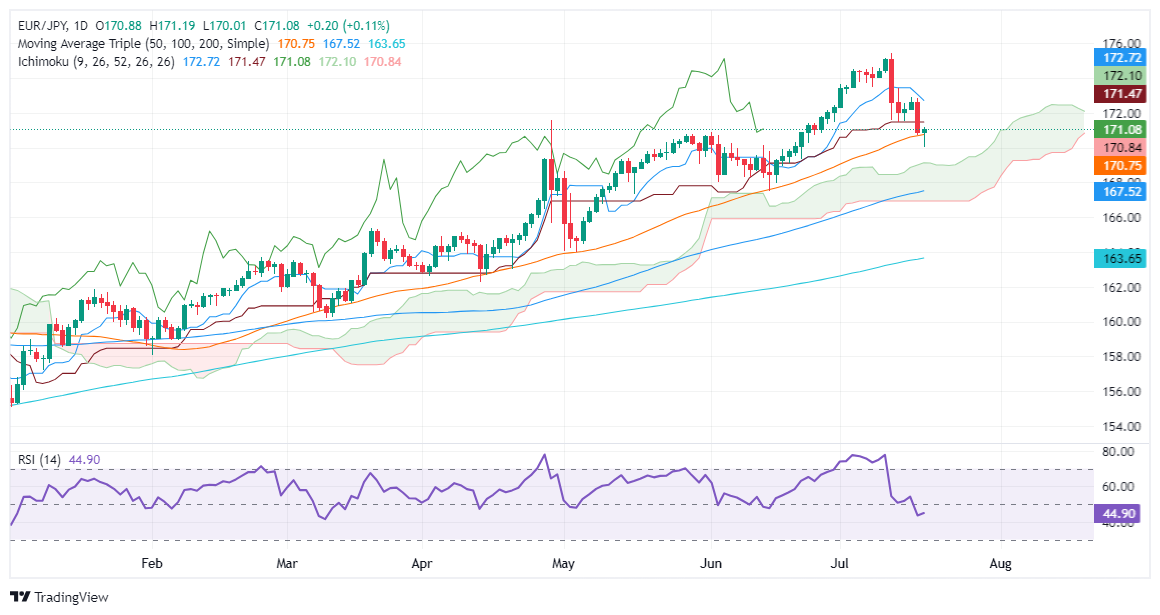- Analiza
- Novosti i instrumenti
- Vesti sa tržišta
- EUR/JPY steadies as ECB’s hold rates, traders eye Lagarde’s presser
EUR/JPY steadies as ECB’s hold rates, traders eye Lagarde’s presser
- EUR/JPY reaches 171.00, peaking at 171.19, after the ECB holds interest rates steady.
- ECB remarks on core inflation: slight increase due to one-off factors, though most metrics stable or decreased in June.
- ECB plans to reduce APP and PEPP portfolios, ceasing principal reinvestments, with an average monthly reduction of €7.5 billion.
The EUR/JPY remains at familiar levels after the European Central Bank decided to keep interest rates unchanged, with its deposit rate at 3.75% as expected, and would stick to its meeting-by-meeting approach, failing to provide an interest rate path. At the time of writing, the cross trades at around 171.00 after hitting a daily high of 171.19.
ECB maintains cautious stance, fails to outline clear rate path
In its monetary policy statement, the ECB mentioned that measures of core inflation edged slightly up due to “one-off factors,” but most measures remained stable or edged down in June. The ECB’s Governing Council noted that the policy “is keeping financing conditions restrictive.” It would keep it as it is “for as long as necessary” to ensure inflation returns to its 2% goal.
Regarding its Aset Purchase Program (APP), the ECB decided not to reinvest all the principal payments on its Asset Purchase Program (APP) and the Pandemic Emergency Purchase Program (PEPP), reducing the portfolio to average €7.5 billion per month.
In the meantime, traders eye ECB’s President Christine Lagarde's press conference at around 12:45 GMT.
EUR/JPY Price Analysis: Technical outlook
The EUR/JPY slid to its daily low of 170.01 during the Asian session, yet it has managed to recover some ground. After the ECB’s decision, it climbed back above the 50-day moving average (DMA)at 170.75.
Nevertheless, momentum remains on the sellers’ side, as the Relative Strength Index (RSI) shifted bearish following the Japanese authority's intervention in the FX space.
However, if EUR/JPY stays above 171.00, that could pave the way to test July’s 17 high of 172.83. On its way up, it would face key resistance levels: the Kijun-Sen at 171.47, followed by the Tenkan-Sen at 172.72. Afterward, buyers could test yesterday’s peak.
On the other hand, if a fall is below 171.00, sellers could challenge the 170.00 figure before prices drop inside the Ichimoku Cloud (Kumo).
ECB FAQs
The European Central Bank (ECB) in Frankfurt, Germany, is the reserve bank for the Eurozone. The ECB sets interest rates and manages monetary policy for the region. The ECB primary mandate is to maintain price stability, which means keeping inflation at around 2%. Its primary tool for achieving this is by raising or lowering interest rates. Relatively high interest rates will usually result in a stronger Euro and vice versa. The ECB Governing Council makes monetary policy decisions at meetings held eight times a year. Decisions are made by heads of the Eurozone national banks and six permanent members, including the President of the ECB, Christine Lagarde.
In extreme situations, the European Central Bank can enact a policy tool called Quantitative Easing. QE is the process by which the ECB prints Euros and uses them to buy assets – usually government or corporate bonds – from banks and other financial institutions. QE usually results in a weaker Euro. QE is a last resort when simply lowering interest rates is unlikely to achieve the objective of price stability. The ECB used it during the Great Financial Crisis in 2009-11, in 2015 when inflation remained stubbornly low, as well as during the covid pandemic.
Quantitative tightening (QT) is the reverse of QE. It is undertaken after QE when an economic recovery is underway and inflation starts rising. Whilst in QE the European Central Bank (ECB) purchases government and corporate bonds from financial institutions to provide them with liquidity, in QT the ECB stops buying more bonds, and stops reinvesting the principal maturing on the bonds it already holds. It is usually positive (or bullish) for the Euro.
© 2000-2024. Sva prava zaštićena.
Sajt je vlasništvo kompanije Teletrade D.J. LLC 2351 LLC 2022 (Euro House, Richmond Hill Road, Kingstown, VC0100, St. Vincent and the Grenadines).
Svi podaci koji se nalaze na sajtu ne predstavljaju osnovu za donošenje investicionih odluka, već su informativnog karaktera.
The company does not serve or provide services to customers who are residents of the US, Canada, Iran, The Democratic People's Republic of Korea, Yemen and FATF blacklisted countries.
Izvršenje trgovinskih operacija sa finansijskim instrumentima upotrebom marginalne trgovine pruža velike mogućnosti i omogućava investitorima ostvarivanje visokih prihoda. Međutim, takav vid trgovine povezan je sa potencijalno visokim nivoom rizika od gubitka sredstava. Проведение торговых операций на финанcовых рынках c маржинальными финанcовыми инcтрументами открывает широкие возможноcти, и позволяет инвеcторам, готовым пойти на риcк, получать выcокую прибыль, но при этом неcет в cебе потенциально выcокий уровень риcка получения убытков. Iz tog razloga je pre započinjanja trgovine potrebno odlučiti o izboru odgovarajuće investicione strategije, uzimajući u obzir raspoložive resurse.
Upotreba informacija: U slučaju potpunog ili delimičnog preuzimanja i daljeg korišćenja materijala koji se nalazi na sajtu, potrebno je navesti link odgovarajuće stranice na sajtu kompanije TeleTrade-a kao izvora informacija. Upotreba materijala na internetu mora biti praćena hiper linkom do web stranice teletrade.org. Automatski uvoz materijala i informacija sa stranice je zabranjen.
Ako imate bilo kakvih pitanja, obratite nam se pr@teletrade.global.
















